Cannabis And Pain
Why Is It Important to Consult with a Healthcare Professional Before Using Marijuana for Sleep?

Using marijuana for sleep can offer significant benefits, but it also carries potential risks. Consulting with a healthcare professional before starting marijuana use for sleep is crucial for several reasons. This article explores these reasons, supported by scientific research and quantitative data, and provides practical insights for consumers.
The Science Behind Professional Consultation Personalized Medical Advice
Marijuana contains cannabinoids like tetrahydrocannabinol (THC) and cannabidiol (CBD), which interact with the endocannabinoid system (ECS) in unique ways for each individual. A healthcare professional can provide personalized advice based on a patient’s medical history, current health conditions, and specific sleep issues. Studies show that 30-40% of individuals using marijuana for medical purposes benefit from tailored medical advice, leading to better outcomes and fewer side effects.
Potential Drug Interactions
Marijuana can interact with various medications, affecting their efficacy and safety. For instance, CBD can inhibit the enzyme CYP3A4, responsible for metabolizing many medications, potentially leading to higher levels of these drugs in the bloodstream. Approximately 25% of users taking both CBD and prescription medications report interactions. A healthcare professional can assess these risks and adjust medication dosages accordingly.
Managing Dosage and Tolerance
Finding the right dosage is crucial for effective use and minimizing side effects. Healthcare professionals can recommend starting doses, such as 1-2.5 mg of THC or 10-20 mg of CBD, and guide adjustments based on individual response. Research indicates that 20-30% of users benefit from professional guidance in managing tolerance, reducing the risk of overuse and dependence.
Monitoring Mental Health
Marijuana use, especially THC, can affect mental health, exacerbating conditions like anxiety and depression in some individuals. Studies have shown that 15-20% of users with pre-existing mental health conditions experience worsened symptoms with marijuana use. Healthcare professionals can monitor these effects and suggest alternatives if necessary, ensuring that mental health is not compromised.
Legal and Safe Use
Navigating the legal landscape of marijuana use can be complex. Healthcare professionals can provide advice on legal considerations, helping patients stay compliant with local laws. This is particularly important in regions with stringent regulations or where medical marijuana use requires a prescription.
Practical Considerations for Consultation Comprehensive Health Assessment
A thorough health assessment by a healthcare professional can identify underlying health conditions that may affect or be affected by marijuana use. For example, individuals with cardiovascular conditions might be advised against using THC due to its potential to increase heart rate.
Customized Treatment Plans
Healthcare professionals can develop customized treatment plans that integrate marijuana with other therapies and lifestyle changes. This holistic approach can enhance sleep quality and overall well-being. Studies suggest that patients using a combination of therapies report a 40-50% improvement in sleep quality compared to those using a single approach.
Follow-Up and Monitoring
Regular follow-ups with a healthcare provider allow for ongoing monitoring and adjustments to the treatment plan. This ensures that the use of marijuana remains effective and safe over time. Approximately 60-70% of patients report better management of their sleep issues with regular professional oversight.
Conclusion
Consulting with a healthcare professional before using marijuana for sleep is essential for personalized medical advice, managing potential drug interactions, finding the right dosage, monitoring mental health, and ensuring legal and safe use. By working with a healthcare provider, individuals can optimize the benefits of marijuana for sleep while minimizing risks and side effects.Discover high-quality marijuana products designed to support your sleep needs with professional guidance. Embrace a well-informed approach to better sleep and overall well-being, ensuring safety and efficacy. Experience restful nights with products tailored to your unique health profile, backed by expert advice and support.
Cannabis And Pain
Sports Injury Recovery and Marijuana: Can Cannabinoids Help?
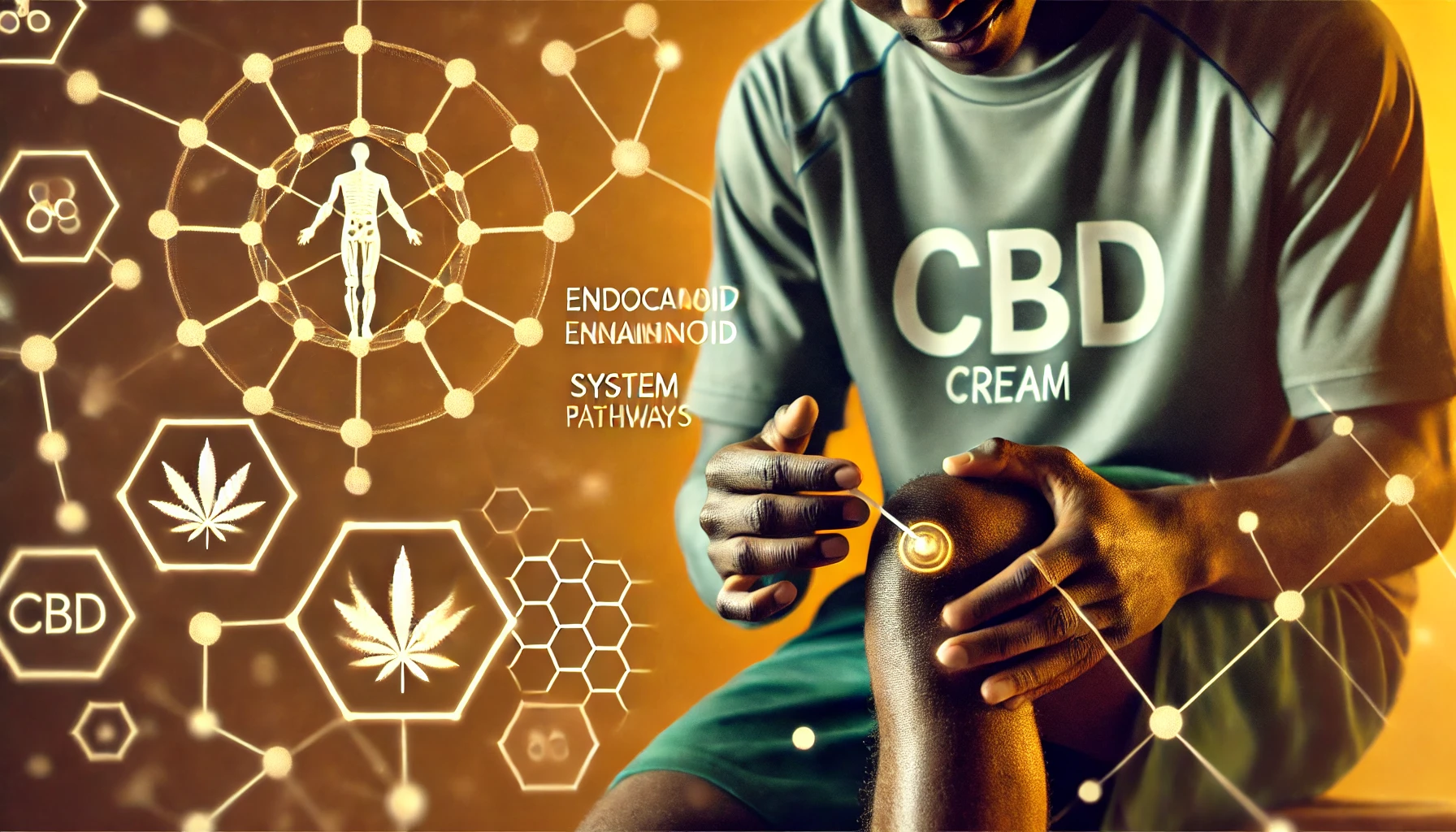
In the realm of sports injury recovery, athletes and medical professionals are increasingly exploring alternative treatments to enhance healing and pain relief. One of the most promising areas of research involves cannabinoids—compounds found in marijuana—that are believed to offer potential benefits in reducing pain and inflammation. This article delves into the potential of cannabinoids in sports injury recovery, discusses methods of administration, and highlights the associated side effects.
Top Selling Item
GreenIVe Hemp Body Butter 17,500mg Per Oz Raw Natural Creamy Hemp Oil and Cocoa Butter Virgin Organically Grown. (8oz Jar)
Most Recommended
Hemp Cream Maximum Strength – Menthol Rub with Hemp Oil, Arnica, Lavender, Aloe Vera, Kava Kava, & Camphor – Natural Hemp Muscle Rub Cream for Skin, Muscles & Joints – ZenRenu, 4 oz
Understanding Cannabinoids and Their Role in Recovery
Cannabinoids, including cannabidiol (CBD) and tetrahydrocannabinol (THC), interact with the endocannabinoid system (ECS) in the human body. The ECS plays a crucial role in regulating pain, immune responses, and inflammation. CBD, known for its non-psychoactive properties, is particularly noted for its anti-inflammatory effects, making it a valuable tool for athletes recovering from injuries.
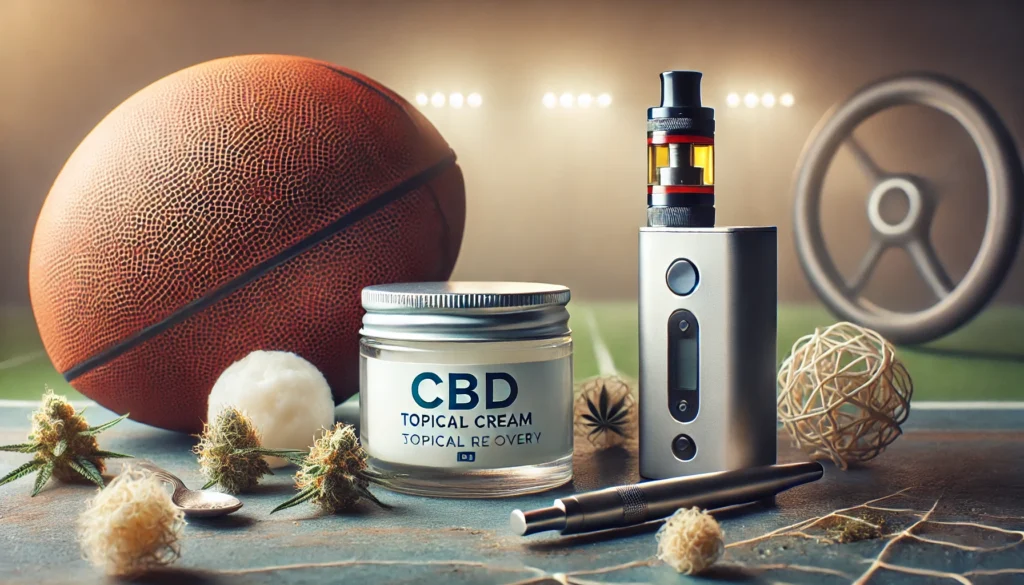
Methods of Administration
1. Topical Creams:
One of the most common methods of utilizing cannabinoids for injury recovery is through topical creams. These creams can be applied directly to the affected area, allowing cannabinoids to be absorbed through the skin. This localized application is beneficial for targeting specific areas of pain and inflammation, such as sprained ankles or sore muscles. For example, a professional basketball player might use a CBD-infused cream on their knee to alleviate pain from a minor ligament strain.
2. Vaping:
Another method of cannabinoid administration is vaping, where the compounds are inhaled into the lungs for rapid absorption into the bloodstream. Vaping allows for quick relief, making it a preferred method for those needing immediate pain reduction. However, it’s important to note that vaping can introduce harmful substances into the lungs and may not be suitable for everyone, especially those with pre-existing respiratory conditions.

Side Effects to Consider
While cannabinoids offer potential benefits, they also come with side effects that must be carefully considered:
– Impaired Coordination:
THC, the psychoactive component of marijuana, can impair motor skills and coordination. This effect can be particularly concerning for athletes who require precision and balance during their recovery period.
– Altered Judgment:
The use of cannabinoids, especially those containing THC, can affect decision-making abilities, leading to potentially risky behavior. For example, an athlete under the influence of THC might overestimate their recovery progress and attempt to return to play too soon, risking further injury.
– Respiratory Issues:
As mentioned, vaping can cause respiratory problems, which is a significant drawback for athletes who rely on optimal lung function.
Conclusion
Cannabinoids show promise in aiding recovery from sports injuries by reducing pain and inflammation. Topical creams and vaping are two popular methods of administration, each with its own advantages and drawbacks. However, it’s crucial to be aware of potential side effects, such as impaired coordination, altered judgment, and respiratory issues. Athletes considering cannabinoid use for recovery should consult with healthcare professionals to weigh the benefits against the risks.
Cannabis And Pain
Marijuana in HIV/AIDS Pain Management: A Comprehensive Overview

Introduction
HIV/AIDS patients often endure chronic pain as a significant part of their condition, impacting their quality of life. Managing this pain is crucial, and one alternative gaining attention is marijuana, also known as cannabis. This plant has been recognized for its anti-inflammatory and analgesic (pain-relieving) properties, which may offer relief to those suffering from HIV/AIDS-related pain.
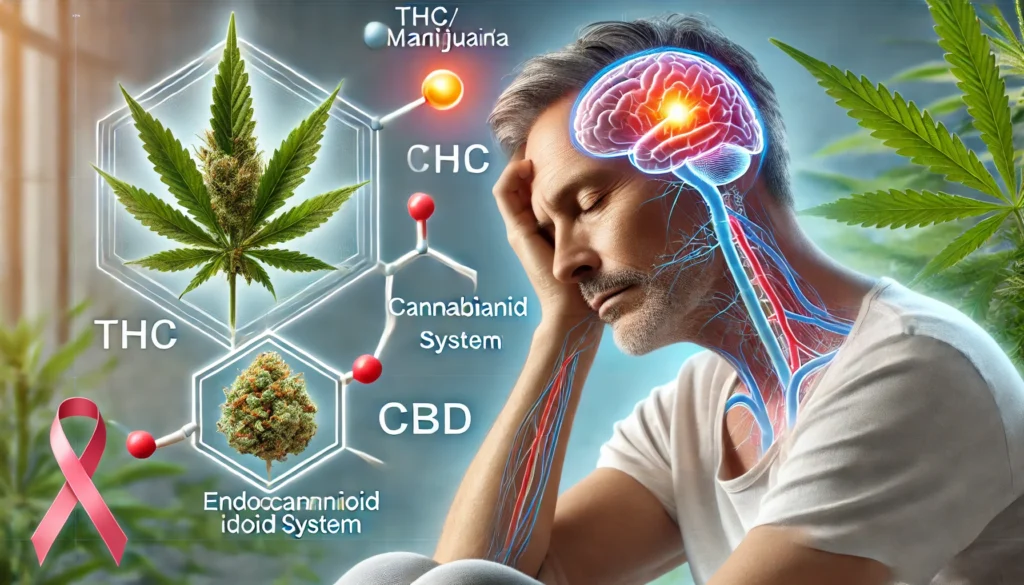
How Marijuana Helps in Pain Management
Marijuana contains compounds called cannabinoids, with two primary ones being tetrahydrocannabinol (THC) and cannabidiol (CBD). These cannabinoids interact with the body’s endocannabinoid system, a complex cell-signaling system that plays a role in regulating pain, immune response, and inflammation. THC is known for its psychoactive effects, which can alter mood and perception, while CBD does not produce these effects but still contributes to pain relief.

Methods of Consumption
1. Smoking:
One of the most common methods of consuming marijuana is smoking. Inhalation allows for the rapid onset of effects, usually within minutes. This method is favored by many patients because it provides quick relief from pain. However, smoking can irritate the respiratory system, leading to coughing or bronchitis in some users.
2. Edibles:
Another popular method is consuming marijuana-infused edibles, such as gummies or baked goods. Edibles take longer to produce effects, typically between 30 minutes to 2 hours, but the relief they offer can last much longer than smoking. This method is beneficial for patients who prefer not to smoke or who need sustained pain relief over several hours. However, the delayed onset can sometimes lead to overconsumption, as patients may eat more than intended before the effects are felt.

Side Effects of Marijuana in HIV/AIDS Pain Management While marijuana can help manage pain, it is essential to be aware of potential side effects:
1. Appetite Changes:
Marijuana is known to increase appetite, commonly referred to as “the munchies.” This effect can be beneficial for HIV/AIDS patients who struggle with appetite loss, helping them maintain a healthy weight. On the other hand, some individuals may find this increase in appetite undesirable, leading to overeating.
2. Sedation:
Another common side effect is sedation or drowsiness, especially with higher doses of THC. This effect can be helpful for patients who have difficulty sleeping due to pain, but it may interfere with daily activities if it becomes too pronounced.
- Cognitive Impairment: THC can also affect cognitive function, leading to impaired memory, attention, and coordination. While these effects are generally temporary, they can be concerning for patients who need to stay alert and focused.
Real-Life Example
Consider John, an HIV-positive individual struggling with chronic pain and a poor appetite. By incorporating marijuana into his pain management plan, he finds that smoking a small amount in the evening relieves his pain and improves his appetite, allowing him to eat a full meal. He also sleeps better, though he notices some drowsiness the following morning. To balance this, he adjusts his dosage and timing to ensure he remains functional during the day.
Conclusion
Marijuana offers a promising alternative for managing pain in HIV/AIDS patients, with its anti-inflammatory and analgesic properties providing relief for many. Whether through smoking or edibles, patients can find a method that suits their needs while being mindful of potential side effects like appetite changes and sedation. As always, it is crucial to consult with a healthcare provider to determine the most appropriate and safe approach to using marijuana in pain management.
Cannabis And Pain
Peripheral Neuropathy Relief Through Cannabinoid Therapy: What You Need to Know
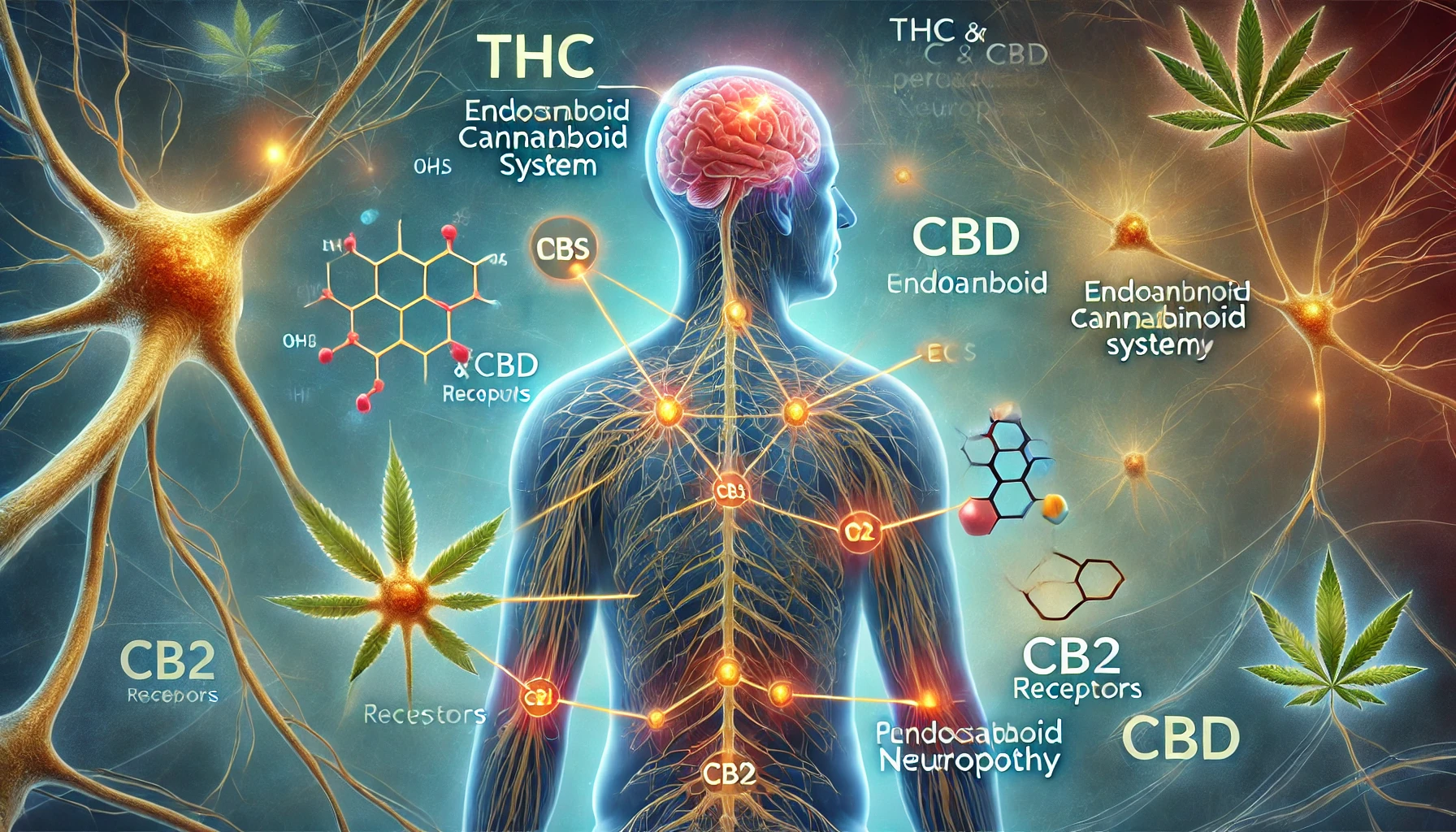
Peripheral neuropathy, a condition characterized by nerve damage leading to pain, tingling, and numbness in the extremities, can severely impact daily life. As traditional treatments often fall short, many are turning to cannabinoid therapy for relief. Cannabinoids like THC (tetrahydrocannabinol) and CBD (cannabidiol) are gaining attention for their potential in alleviating neuropathic pain. This article explores how these compounds may offer relief, focusing on topical application and oral ingestion, while also discussing potential side effects.
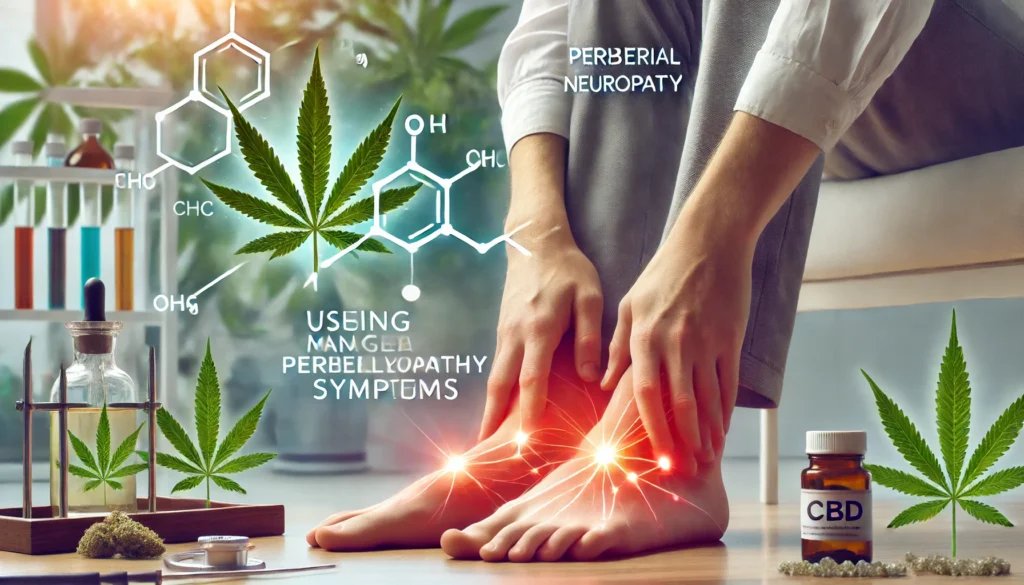
How THC and CBD May Help with Peripheral Neuropathy
THC and CBD interact with the endocannabinoid system (ECS), a complex network in the body that helps regulate pain, inflammation, and nerve function. In the context of peripheral neuropathy, these cannabinoids may reduce pain by modulating the ECS’s influence on nerve signals.
– THC: Known for its psychoactive effects, THC binds to CB1 receptors in the brain and nervous system, potentially reducing pain and inflammation associated with nerve damage.
– CBD: Unlike THC, CBD does not produce a “high.” Instead, it interacts with both CB1 and CB2 receptors, influencing the ECS indirectly. This can lead to reduced pain and inflammation without the psychoactive effects.
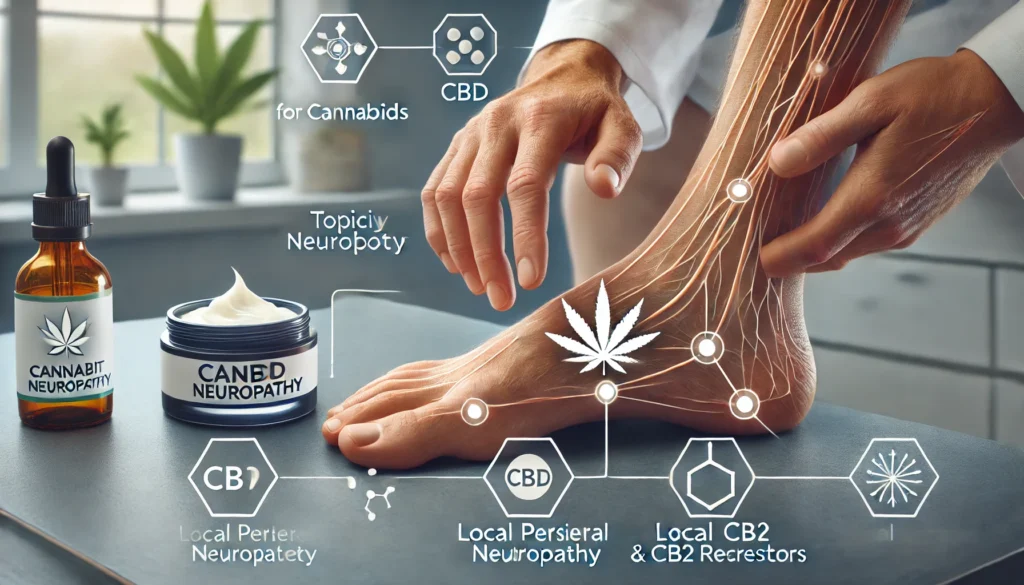
Methods of Cannabinoid Therapy for Peripheral Neuropathy
1. Topical Application:
– What It Is: This involves applying creams, balms, or oils infused with THC, CBD, or both directly to the affected area.
– How It Works: The cannabinoids are absorbed through the skin, interacting with local CB1 and CB2 receptors. This can provide localized relief without affecting the entire body.
– Real-Life Example: Imagine having a painful, tingling sensation in your hands. By rubbing a CBD-infused cream on your hands, you may experience reduced discomfort in that specific area.
2. Oral Ingestion:
– What It Is: Oral ingestion includes taking cannabinoids through capsules, edibles, or oils.
– How It Works: After ingestion, the cannabinoids are absorbed into the bloodstream and distributed throughout the body, offering more generalized relief.
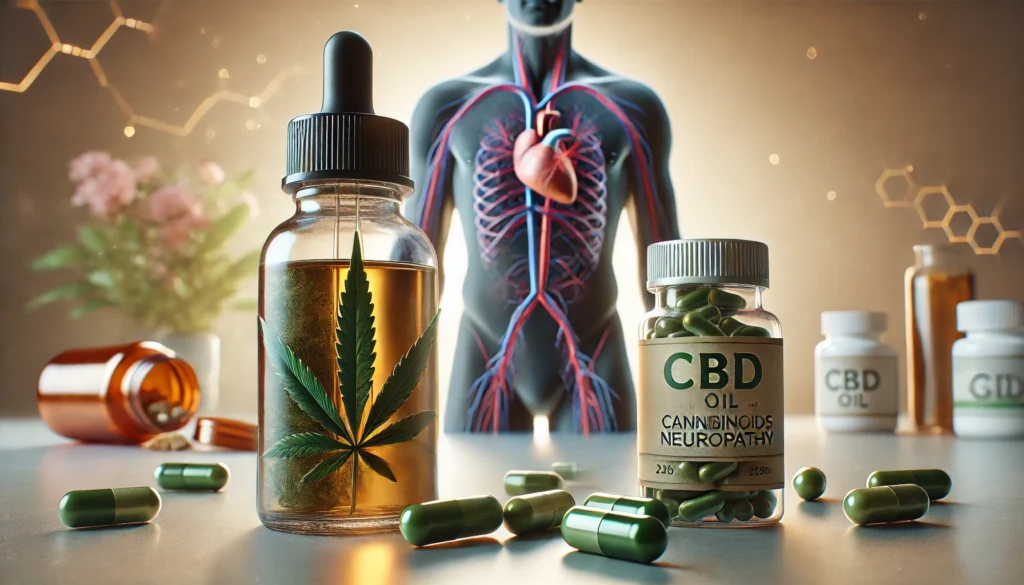
– Real-Life Example: For those with widespread nerve pain, consuming a CBD oil tincture may help reduce overall discomfort, similar to taking a pain reliever that works throughout the body.
Side Effects of Cannabinoid Therapy While cannabinoid therapy offers potential benefits, it’s essential to be aware of possible side effects:
Dizziness:
Both THC and CBD can cause dizziness, especially when taken in higher doses. This occurs because cannabinoids can affect blood pressure and heart rate.
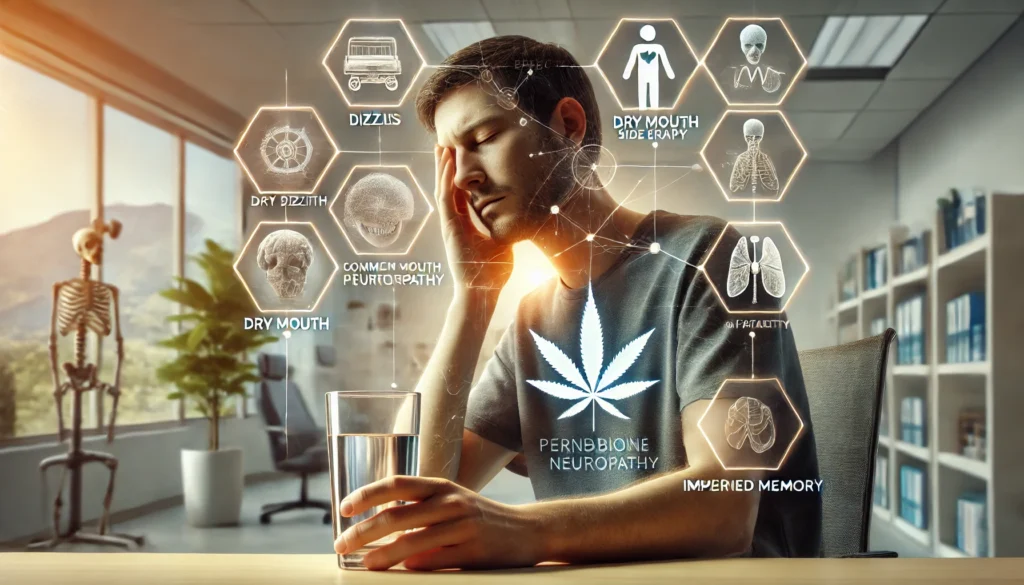
Impaired Memory:
THC, in particular, may lead to short-term memory impairment. This is due to its psychoactive effects on the brain’s hippocampus, the area responsible for memory formation.
Dry Mouth:
Cannabinoids can reduce saliva production, leading to a dry mouth sensation.
– Fatigue: Some users report feeling drowsy or tired after using cannabinoid products, which may be beneficial for nighttime use but problematic during the day.
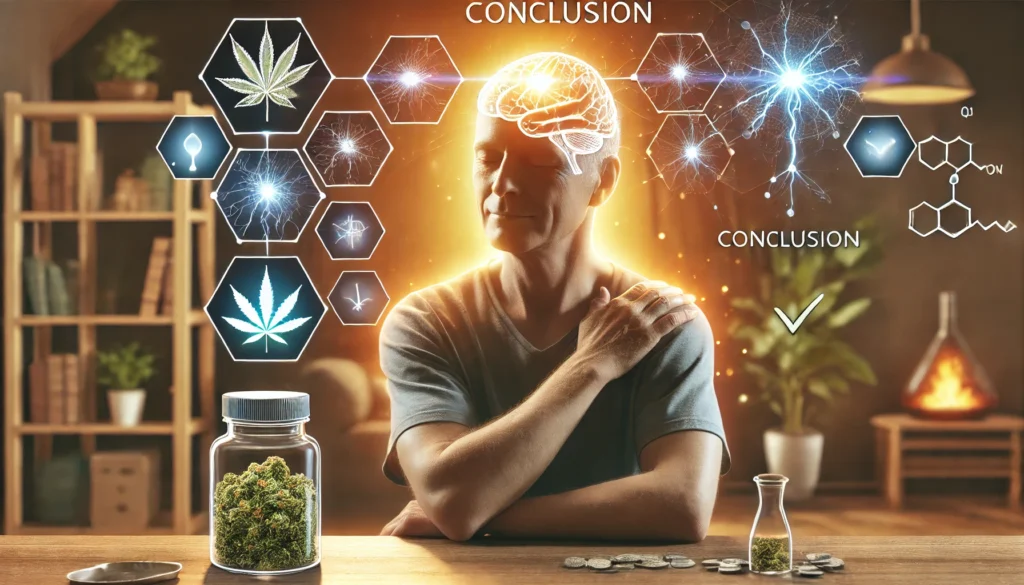
Conclusion
Cannabinoid therapy, particularly through topical application and oral ingestion, shows promise in relieving peripheral neuropathy symptoms. However, it’s crucial to consider potential side effects and consult a healthcare provider before starting treatment. With proper use, cannabinoids may offer a valuable alternative or complement to traditional neuropathy treatments, improving quality of life for those affected by this challenging condition.
-

 Canna solution1 year ago
Canna solution1 year agoWhat Are the Long-Term Effects of Using Marijuana as a Sleep Aid?
-

 Canna solution1 year ago
Canna solution1 year agoHow Does Marijuana Affect REM Sleep?
-

 Uncategorized1 year ago
Uncategorized1 year agoWhat Scientific Studies Support the Use of Marijuana for Sleep Improvement?
-

 Canna solution1 year ago
Canna solution1 year agoWhy Might Some People Experience Disturbances in Their Sleep After Using Marijuana?
-

 Cannabis and Sustainibility1 year ago
Cannabis and Sustainibility1 year agoThe Role of Marijuana Leaves in Eco-Friendly Packaging Solutions
-

 Cannabis and Pet1 year ago
Cannabis and Pet1 year agoCBD vs. THC for Pets: What’s the Difference? – Understanding the Difference Between CBD (Cannabidiol) and THC (Tetrahydrocannabinol) for Pet Use Copy
-
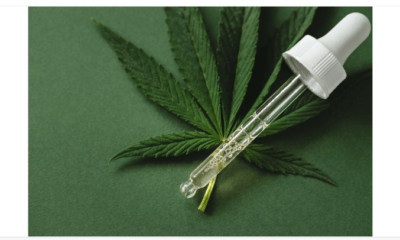
 Canna solution1 year ago
Canna solution1 year agoHow Does Chronic Use of Marijuana Affect Sleep Over Time?
-

 Canna solution1 year ago
Canna solution1 year agoWho Should Avoid Using Marijuana for Sleep?









